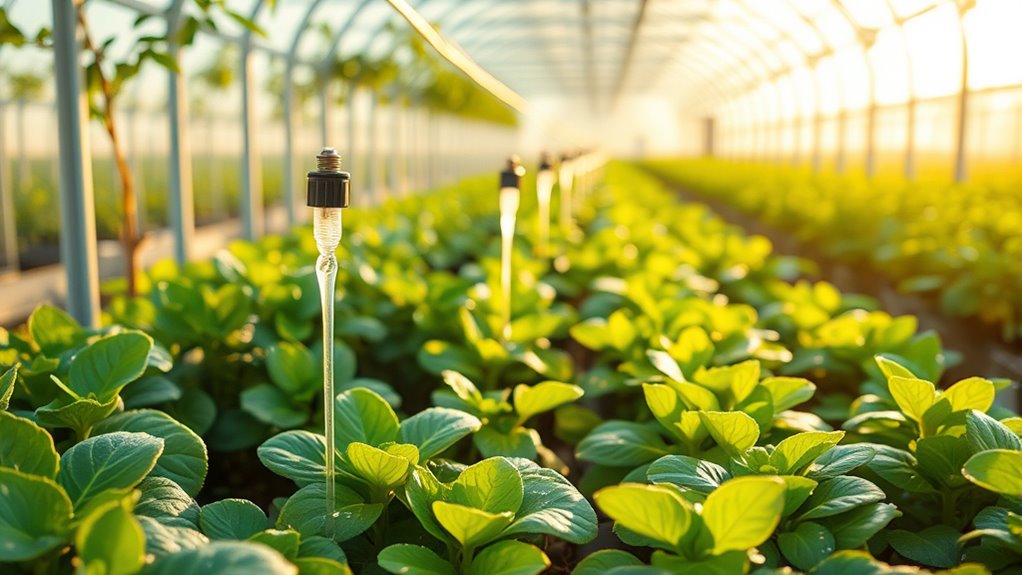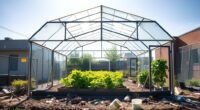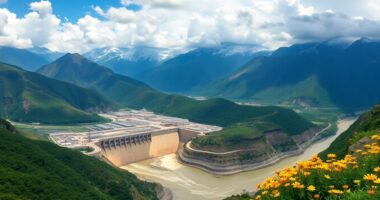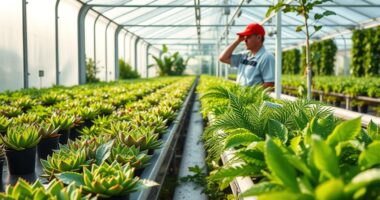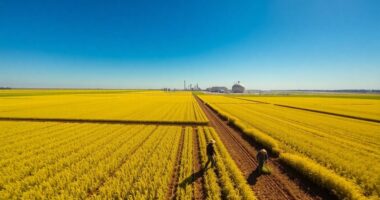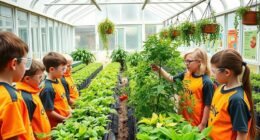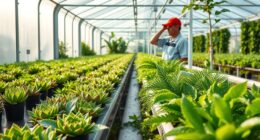Implementing drip irrigation in your greenhouse helps you save water by delivering it directly to plant roots, reducing runoff and evaporation. This targeted approach guarantees consistent soil moisture, promoting healthy growth while minimizing waste. It also lessens weed growth and disease risks by keeping surrounding areas dry. Automation options further boost efficiency. By adopting drip irrigation, you’ll optimize water use and improve crop health, and if you keep exploring, you’ll discover even more ways to maximize its benefits.
Key Takeaways
- Drip irrigation delivers water directly to plant roots, minimizing runoff and evaporation in greenhouse environments.
- Automating drip systems ensures precise, scheduled watering, reducing waste and labor.
- Targeted watering maintains optimal soil moisture, promoting healthier plants and efficient fertilizer use.
- Using drip irrigation reduces weed growth and disease by limiting excess surface moisture.
- Implementing efficient drip systems supports water conservation and sustainable practices within greenhouses.
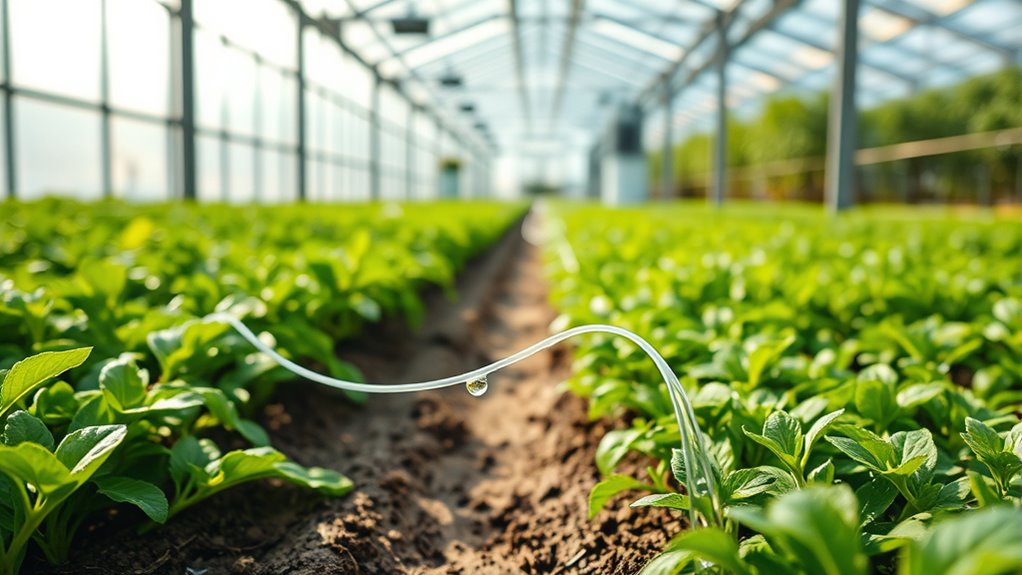
Implementing drip irrigation can considerably improve water efficiency and crop yields in your garden or farm. When you set up a drip system, you deliver water directly to the root zones of your plants, which helps maintain ideal soil moisture levels. Unlike traditional watering methods that often waste water through runoff or evaporation, drip irrigation minimizes these losses by providing a slow, steady supply of water exactly where it’s needed most. This precise delivery not only conserves water but also creates a consistent environment that encourages healthy plant growth. As a result, your crops receive the right amount of moisture, reducing the risk of both drought stress and overwatering, which can lead to root rot or other issues.
Maintaining proper soil moisture is essential for maximizing crop productivity. With drip irrigation, you gain better control over how much water your plants receive, making it easier to adapt to different soil types and plant needs. When soil moisture levels are stable, plants can absorb nutrients more effectively, leading to improved fertilizer efficiency. This means you get more growth per unit of fertilizer applied, saving you money and reducing potential environmental impacts from fertilizer runoff. By avoiding over-fertilization and ensuring nutrients are readily available in the soil, you support healthier roots and stronger plants. Additionally, water conservation is a key benefit that aligns with sustainable farming practices.
Another advantage is that drip irrigation reduces weed growth. Since water is delivered directly to your crops, the surrounding soil remains drier, discouraging weeds from sprouting and competing for nutrients. This targeted watering also lessens the likelihood of fungal diseases that thrive in overly moist conditions, which can be common in traditional watering methods. By creating a cleaner, more controlled environment, you’re protecting your plants and improving their overall health.
In a greenhouse setting, implementing drip irrigation becomes even more beneficial. You can automate the system to deliver precise amounts of water at specific times, ensuring your plants always receive ideal moisture levels. This automation helps you save labor and reduces the chances of human error, such as over- or under-watering. Additionally, it minimizes water waste in controlled environments, which is especially important when water resources are limited. The system’s ability to keep soil moisture consistent also fosters better root development and increases crop yields, making your greenhouse operation more efficient and sustainable.
Frequently Asked Questions
What Are the Initial Costs of Installing Drip Irrigation Systems?
The initial cost of installing drip irrigation systems typically ranges from $500 to $2,500, depending on your greenhouse size and the complexity of the setup. Your cost estimation includes materials, such as hoses, emitters, and filters, as well as installation procedures. You’ll need to take into account labor costs if you hire professionals, but you can also save money by doing some installation yourself. Planning carefully helps make certain your investment is well spent.
How Often Should Drip Emitters Be Maintained or Replaced?
You might worry about maintenance costs, but with proper care, drip emitters don’t need frequent replacements. Generally, you should follow a regular maintenance schedule, inspecting emitters every 3 to 6 months. Replacement frequency depends on water quality and usage, but typically, emitters last 1 to 2 years. Regular cleaning and checking for clogs guarantee your system stays efficient, saving water and reducing long-term expenses.
Can Drip Irrigation Be Integrated With Existing Greenhouse Automation?
Yes, you can integrate drip irrigation with your existing greenhouse automation. You need to verify system compatibility by checking if your current automation system supports irrigation controls. Automation integration allows you to schedule watering times, monitor water usage, and adjust flow rates remotely. This streamlines operations and conserves water efficiently. Just verify compatibility first, then follow manufacturer guidelines to seamlessly connect your drip system with your automation setup.
What Are Common Troubleshooting Issues With Drip Irrigation?
Think of your drip system like a delicate dance, where every step counts. Common issues include clogging, which can block water flow, and emitter leakage, wasting precious water. To keep it running smoothly, regularly flush filters, check for clogs, and replace leaking emitters promptly. Staying vigilant guarantees your plants get the right amount of water, making your greenhouse thrive like a well-orchestrated symphony.
How Does Drip Irrigation Impact Plant Disease Prevention?
Drip irrigation helps prevent plant diseases by reducing water contact on foliage, which aids in disease suppression and pathogen control. You’ll notice fewer issues like mold or fungal infections because the system delivers water directly to the roots, keeping leaves dry. This targeted watering minimizes excess moisture that fosters disease development, promoting healthier plants and reducing the need for chemical treatments. Overall, it’s an effective way to maintain a cleaner, disease-free greenhouse environment.
Conclusion
Just as the wise gardener of old knew the value of careful watering, you now hold the power to transform your greenhouse with drip irrigation. By adopting this efficient system, you’re not just saving water—you’re nurturing a sustainable future, much like planting seeds of change. Embrace this method today, and watch your crops thrive while conserving precious resources, echoing the timeless wisdom that true growth begins with mindful care.
